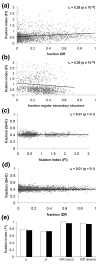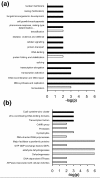Proteome-wide evidence for enhanced positive Darwinian selection within intrinsically disordered regions in proteins
- PMID: 21771306
- PMCID: PMC3218827
- DOI: 10.1186/gb-2011-12-7-r65
Proteome-wide evidence for enhanced positive Darwinian selection within intrinsically disordered regions in proteins
Abstract
Background: Understanding the adaptive changes that alter the function of proteins during evolution is an important question for biology and medicine. The increasing number of completely sequenced genomes from closely related organisms, as well as individuals within species, facilitates systematic detection of recent selection events by means of comparative genomics.
Results: We have used genome-wide strain-specific single nucleotide polymorphism data from 64 strains of budding yeast (Saccharomyces cerevisiae or Saccharomyces paradoxus) to determine whether adaptive positive selection is correlated with protein regions showing propensity for different classes of structure conformation. Data from phylogenetic and population genetic analysis of 3,746 gene alignments consistently shows a significantly higher degree of positive Darwinian selection in intrinsically disordered regions of proteins compared to regions of alpha helix, beta sheet or tertiary structure. Evidence of positive selection is significantly enriched in classes of proteins whose functions and molecular mechanisms can be coupled to adaptive processes and these classes tend to have a higher average content of intrinsically unstructured protein regions.
Conclusions: We suggest that intrinsically disordered protein regions may be important for the production and maintenance of genetic variation with adaptive potential and that they may thus be of central significance for the evolvability of the organism or cell in which they occur.
Figures






Similar articles
-
Evolutionary Forces and Codon Bias in Different Flavors of Intrinsic Disorder in the Human Proteome.J Mol Evol. 2020 Mar;88(2):164-178. doi: 10.1007/s00239-019-09921-4. Epub 2019 Dec 10. J Mol Evol. 2020. PMID: 31820049
-
Polymorphism Analysis Reveals Reduced Negative Selection and Elevated Rate of Insertions and Deletions in Intrinsically Disordered Protein Regions.Genome Biol Evol. 2015 Jun 4;7(6):1815-26. doi: 10.1093/gbe/evv105. Genome Biol Evol. 2015. PMID: 26047845 Free PMC article.
-
Proteome-wide signatures of function in highly diverged intrinsically disordered regions.Elife. 2019 Jul 2;8:e46883. doi: 10.7554/eLife.46883. Elife. 2019. PMID: 31264965 Free PMC article.
-
Coding Regions of Intrinsic Disorder Accommodate Parallel Functions.Trends Biochem Sci. 2016 Nov;41(11):898-906. doi: 10.1016/j.tibs.2016.08.009. Epub 2016 Sep 16. Trends Biochem Sci. 2016. PMID: 27647212 Review.
-
Bioinformatical approaches to characterize intrinsically disordered/unstructured proteins.Brief Bioinform. 2010 Mar;11(2):225-43. doi: 10.1093/bib/bbp061. Epub 2009 Dec 10. Brief Bioinform. 2010. PMID: 20007729 Review.
Cited by
-
Globular and disordered-the non-identical twins in protein-protein interactions.Front Mol Biosci. 2015 Jul 9;2:40. doi: 10.3389/fmolb.2015.00040. eCollection 2015. Front Mol Biosci. 2015. PMID: 26217672 Free PMC article.
-
Binding of the N-terminal region of coactivator TIF2 to the intrinsically disordered AF1 domain of the glucocorticoid receptor is accompanied by conformational reorganizations.J Biol Chem. 2012 Dec 28;287(53):44546-60. doi: 10.1074/jbc.M112.411330. Epub 2012 Nov 6. J Biol Chem. 2012. PMID: 23132854 Free PMC article.
-
A genomic scale map of genetic diversity in Trypanosoma cruzi.BMC Genomics. 2012 Dec 27;13:736. doi: 10.1186/1471-2164-13-736. BMC Genomics. 2012. PMID: 23270511 Free PMC article.
-
Evolutionary Forces and Codon Bias in Different Flavors of Intrinsic Disorder in the Human Proteome.J Mol Evol. 2020 Mar;88(2):164-178. doi: 10.1007/s00239-019-09921-4. Epub 2019 Dec 10. J Mol Evol. 2020. PMID: 31820049
-
A comparative study of Whi5 and retinoblastoma proteins: from sequence and structure analysis to intracellular networks.Front Physiol. 2014 Jan 21;4:315. doi: 10.3389/fphys.2013.00315. eCollection 2013. Front Physiol. 2014. PMID: 24478706 Free PMC article.
References
-
- Sabeti P, Reich D, Higgins J, Levine H, Richter D, Schaffner S, Gabriel S, Platko J, Patterson N, McDonald G, Ackerman H, Campbell S, Altshuler D, Cooper R, Kwiatkowski D, Ward R, Lander E. Detecting recent positive selection in the human genome from haplotype structure. Nature. 2002;419:832–837. doi: 10.1038/nature01140. - DOI - PubMed
Publication types
MeSH terms
Substances
LinkOut - more resources
Full Text Sources
Other Literature Sources
Molecular Biology Databases

